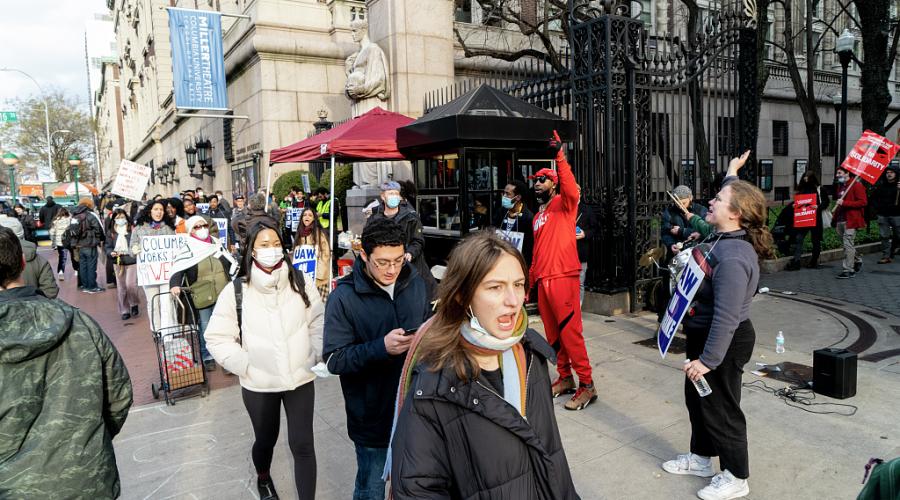
The Labor Movement’s Expansion in American Higher Education
By Suraj Parikh ‘25 | Editor, Scheinman Institute Newsletter and Blog
Over the last few years, higher education in America has seen a substantial amount of collective militant actions, including union organizing and hard bargaining.
Notable collective efforts include adjunct faculty using militancy to gain improvements to wages and working conditions. For example, Rutgers University recently faced an historic and high-profile strike, where multiple faculty unions won substantial salary increases and job security improvements. Professor Harry Katz, Jack Sheinkman Professor of Collective Bargaining at the ILR School and Director of the Scheinman Institute said that non-tenure track faculty members, who often have “advanced degrees, high workloads, and low pay”, have been particularly active in recent times. Katz notes that the percentage of tenure track faculty has been dropping over the past 25 years, leading many colleges and universities to shift teaching to adjunct faculty, especially for institutions in urban areas with an accessible supply of this specialized labor. This shift has included attempts by a growing number of adjunct faculty members to organize and use collective bargaining to gain increased wages and job security, as occurred at Rutgers. Katz also points out that a similar trend is occurring at two-year junior colleges, where faculty are not tenure track and receive much lower pay than faculty members at four-year institutions.
Graduate students, who often conduct a significant amount of the classroom instruction at many colleges and universities, have also seen incredible organizing success in recent years. Last year, America’s largest strike was a six-week long struggle of 48,000 graduate student workers at the University of California, who eventually won better pay and benefits. Katz sees the shift in attitudes towards unionization revealed in recent polls, especially the strong support that unions enjoy among college-aged Americans, as critical to the recent advances in academic unionism. He also notes that graduate students face significant economic pressure since they have to live on relatively modest stipends for long periods of time – Ph.D. candidates and postdoctoral students could be living on low-paying stipends for as long as eight to ten years.
Professor Richard Hurd, emeritus ILR Associate Dean for External Relations and professor of labor relations, offers important insights into Cornell’s own history with graduate student organizing. Cornell has had multiple unsuccessful campaigns to unionize graduate student workers, but some key themes have emerged from these attempts. Hurd notes that Cornell administration’s past union avoidance campaigns were not “aggressively anti-union”, but rather centered around a “positive HR” strategy. The administrations at the time used various means to encourage graduate students to vote against the union and even sent letters to students and their families detailing the university’s arguments against unionization. Hurd also mentioned the differences in views towards unions held by graduate students in the humanities and social sciences versus those in STEM fields during these campaigns. The university’s union avoidance efforts tapped into the fears held by graduate students in the sciences (who were often conducting laboratory experiments) that their research and academic progress could be damaged by a work stoppage. Additionally, he says, many students simply did not want to challenge their faculty supervisors. Katz also described additional factors that made organizing difficult, including international students’ vulnerability to potential retaliation by the university, many students’ lack of familiarity with unions, and a relatively higher turnover rate among graduate students compared to workers in other industries. At the same time, Hurd and Katz both note that the high support for unions expressed by many students provides favorable conditions for potential unionization attempts going forward. Katz adds that graduate students have significant potential bargaining power because they are “not easily replaceable like factory labor often is” and because universities “have to worry about their image with alumni, donors, and the public”. These factors give graduate students an opportunity to use collective power to achieve better pay and improvements in their employment conditions.
At some universities undergraduate students are also seeking to use their collective power. Undergraduate student workers in the California State University system, America’s largest four-year university system, along with students at other schools including Harvard, Columbia, and Dartmouth, have formed unions and are fighting for improved working conditions. Katz says that since undergraduate students generally work on a part-time basis and have much faster turnover rates than graduate students and many other workers, they may face more difficulties in union organizing campaigns. At the same time, since the favorable public opinion that young Americans have towards unions extends to undergraduates, there is a favorable environment for organizing campaigns. A successful example of such efforts occurred when undergraduate dining hall workers at Dartmouth were able to win a $21 base wage in just over a year after winning a union representation election. As students at other Ivy League institutions and across the country learn about this kind of success, they too may seek to organize unions.
All of these examples reveal that for many types of employees and students working and studying in the U.S., the labor movement is being increasingly seen in a positive light. Faculty, graduate students, and undergraduates at many universities are seeking to organize and bargain for better employment terms and conditions. Hurd sees academic workers’ situation like this: “There are times in history when there’s a chance to do something, and you have to grab it while it’s there – the question many in higher education are now asking is whether unionism can step in and do something.”
